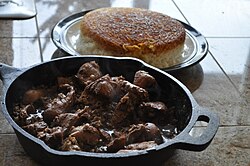 A bowl of chicken fesenjān, with Persian rice topped by tahdig A bowl of chicken fesenjān, with Persian rice topped by tahdig | |
| Alternative names | Fesenjan, Fesenjoon |
|---|---|
| Type | Stew |
| Course | Main course |
| Place of origin | |
| Region or state | |
| Associated cuisine | Iranian cuisine |
| Created by | Iranians |
| Main ingredients | Pomegranate juice, walnuts, poultry (duck or chicken) |
| Variations | Lamb meatballs |
Fesenjān (Persian: فسنجان; also called fesenjoon in Tehrani dialect) is a sweet and sour Iranian stew (a khoresh). The roots of this Persian delicacy trace back to the Sassanid dynasty's golden age. It is typically served over rice in the Iranian manner. In Iran, it is made with minced meat (lamb, sheep or beef), meatballs, chicken or duck. Like other khoresh stews served over rice, fesenjan is common also to Iraqi cuisine. As a festive dish for special occasions, it has become part of Jewish Rosh Hashannah celebrations, even though the typology of Jewish ethnic cuisines is imprecise. In Azerbaijan, where it called fisincan plov, the stew is made with lamb meatballs instead of poultry.
About
Fesenjān is flavored with pomegranate paste and ground walnuts (see bazha) and spices like turmeric, cinnamon, orange peel, cardamom, and rosebud. It is traditionally made with eggplant and poultry (duck or chicken). Fesenjān can also be made using balls of ground meat or chunks of lamb. Depending on the recipe, it can have a sweet or sour taste. Fesenjān is served with Iranian white or yellow rice (polo or chelo).
If the pomegranate sauce comes out too sour, sugar and fried onions may be added to sweeten it. Sometimes, a hot iron is applied to cause oxidation and darken the sauce's color.
It is a dish that is part of the dinner table on Yaldā Night celebrations.
History
The earliest known reference to fesenjān is in Mirza Ali-Akbar Khan Ashpazbashi's Sofra-ye at'ema from 1881, which lists ten different varieties of the dish: walnut (today the most common), almond, eggplant, kidney bean, quince, potato, carrot, pumpkin, fish, and yogurt. The first dictionary to mention fesenjān is the Farhang-e Anandraj, which calls it fasūjan.
Culture
Fesenjān is an elaborate dish that is often reserved for special occasions. It is considered "a rich man's dish", which is referenced in the Persian expression "he behaves as if he has had partridge and fesenjān", meaning to show off or act pretentiously.
In the traditional Iranian system of garm and sard foods (i.e. "hot" and "cold", respectively), fesenjān is considered "hot" because it uses walnuts, which are also considered a "hot" food. In order to balance out this hotness, sometimes people will add coriander (a "cold" plant) to it; peeled pumpkin is also added for the same reason, as well as to act as a sugar substitute.
See also
References
- "Fesenjoon is one of the best Persian food". Tehran Times. 2020-01-14. Retrieved 2024-06-11.
- Anderson, E.N. (30 April 2018). Asian Cuisines: Food Culture from East Asia to Turkey and Afghanistan. Berkshire Publishing Group. p. 99. ISBN 9781614728467.
- Amanat, Abbas; Vejdan, Farzin, eds. (2012). Iran Facing Others: Identity Boundaries in a Historical Perspective. Palgrave Macmillan.
- The Oxford Handbook of the Jewish Diaspora, Oxford University Press, 2021, p. 683
- Fisincan Plov Nasıl Yapılır? - Can Azerbaycan - TRT Avaz (in Azerbaijani).
- ^ Miers, Thomasina (2017-12-15). "Thomasina Miers' recipe for roast winter vegetables with walnut and pomegranate sauce". the Guardian. Retrieved 2018-07-26.
Richly sweet, subtly sour, with a satisfying depth of flavour from ground walnuts: fesenjan is a tempting Persian stew traditionally eaten during the winter solstice.
- ^ Davidson, Alan (2014). Jaine, Tom (ed.). The Oxford Companion to Food (3 ed.). Oxford University Press. p. 48. ISBN 978-0199677337.
- ^ Elahi, Etrat. "FESANJĀN". Encyclopaedia Iranica. Retrieved 6 March 2022.
External links
| Iranian cuisine | |||||||||
|---|---|---|---|---|---|---|---|---|---|
| Ingredients |
| ||||||||
| Breads and nans | |||||||||
| Salads |
| ||||||||
| Cheeses | |||||||||
| Soups and āshes |
| ||||||||
| Dishes |
| ||||||||
| Sauces | |||||||||
| Hors d'oeuvre | |||||||||
| Sweets and desserts | |||||||||
| Beverages | |||||||||
| Instruments | |||||||||
| Related cuisines | |||||||||
This Azerbaijani cuisine-related article is a stub. You can help Misplaced Pages by expanding it. |
This Persian cuisine-related article is a stub. You can help Misplaced Pages by expanding it. |
This article about Afghan cuisine is a stub. You can help Misplaced Pages by expanding it. |
This Turkish cuisine-related article is a stub. You can help Misplaced Pages by expanding it. |